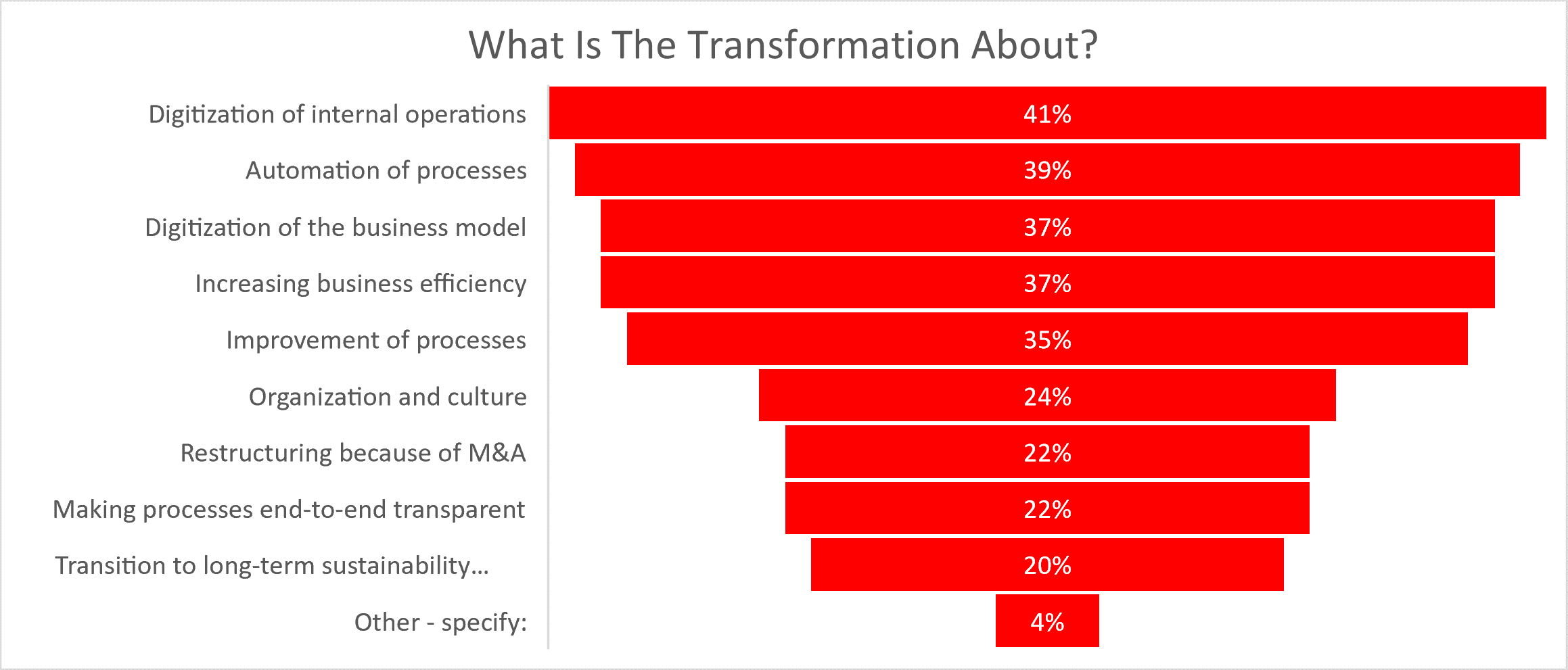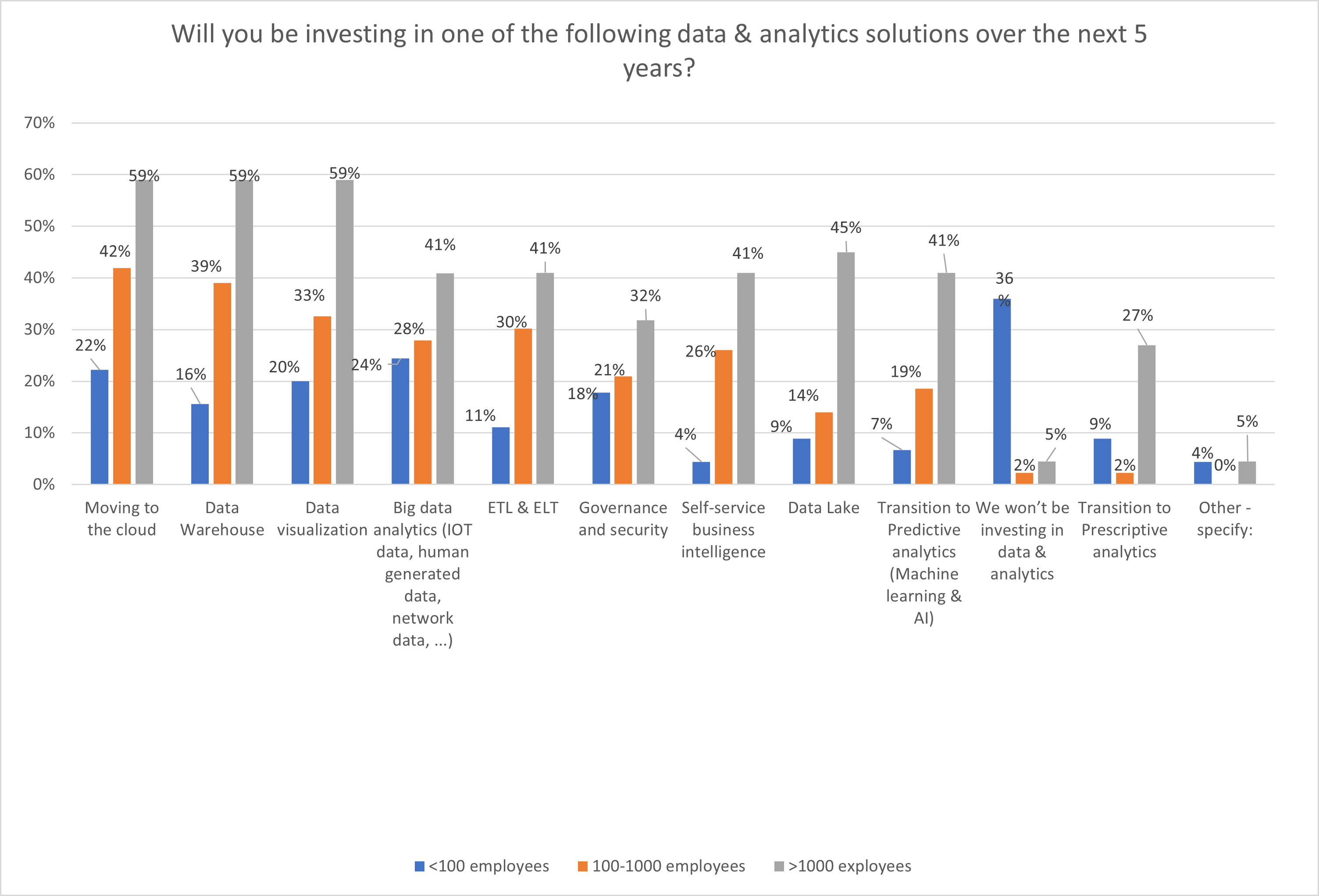Transforming the Organization
22 December 2022FOCUS ON THE FUTURE OF YOUR BUSINESS 3:
Belgian Executives Embracing Change
The TriFinance 2022 survey on talent, change, and sustainable growth reveals a clear trend regarding transformations: fewer Belgian companies (4 out of 10) than companies with decision centers abroad (6 out of 10) are currently undergoing a transformation. Typically, these are large, listed companies
Transforming to digitize
In the case of a transformation, digitization and automation are the prime goals. 40 percent are digitizing their internal operations or automating their processes.
Digitization of the business model and improving business efficiency rank third. On average, and independent of the companies that are digitizing their business model, Belgian companies have spent 20 percent of their annual budget on that transformation over the past five years.

Transformation goals
In the case of a transformation, digitization and automation are the prime goals. 40 percent are digitizing their internal operations or automating their processes.
Digitization of the business model and improving business efficiency rank third. On average, and independent of the companies that are digitizing their business model, Belgian companies have spent 20 percent of their annual budget on that transformation over the past five years.
In general, transformations aim at increasing efficiency and/or optimizing or re-engineering processes.
Significantly fewer participants mentioned corporate restructuring as the main reason for transformation, be it of the organization (and its culture) or of the organization after a takeover or merge.
Process Automation
Companies that are currently transforming are very positive about the automation degree of their processes. They estimate that half of their processes will be automated by 2030. On average, executives think 40 percent of their business processes will be automated by then. Large companies are a bit more optimistic, expecting that 60 percent of their processes will be automated in the next few years. Companies that are not undergoing a transformation, have significantly more often not automated their processes.
The process that is most often fully automated is Order to Cash (50 percent of participants). Other processes, such as Record to Report, Make to Deliver, Plan to Inventory, Hire to Retire, or Plan to Produce are rarely fully automated. The only exception there is Procure to Pay, of which 20 percent of participating executives say it is fully automated.
Larger companies expect that 60 percent of their processes will be automated in the next few years. 46 percent of participants say that the Hire to Retire process is not automated in their companies.
Zooming in on automation
More often, these processes have been partially automated. All of the processes mentioned above have at least been partially automated by nearly half of the participating companies. A striking result was the 46 percent of participants saying that the Hire to Retire process in their companies is not automated.
‘Zooming in on automation: manufacturing processes are most often automated with robots,’ CFO Services Client Partner Filip Ceulemans says. ‘Further down the ladder is a process like Order to Cash. As we learned from our survey results, only half of participating companies have it fully automated.
From experience, we also know that HR has been lagging behind because it is struggling with the complexity and fragmentation of the HR Tech stack. There are simply too many tools there, that are often poorly designed, leading to, redundancies, and inaccuracies, So it is the fragmentation and heterogeneity of the HR Tech stack that is probably holding companies back.
The exception is of course payroll, which is the HR process with the highest degree of automation, primarily due to the fact that, in Belgium, it is also the HR process that is most often outsourced. In the last few years, however, automation of HR processes is gaining ground.’
Transformation and Attracting Talent
An interesting finding is that companies undergoing a transformation tend to work more intensively on attracting key talent. Although they use the same methods as all other companies, we noticed significant differences in the use of
- flex or hybrid work regimes (48 percent vs 28 percent of companies not in transformation);
- continuous learning (50 percent vs 26 percent)
- top-of-class technology (28 percent vs 6 percent).
For companies in transformation, continuous learning (63 percent vs 38 percent) is by far the most popular answer to the retention issue that all companies struggle with.
Companies going through a transformation put significantly more effort into attracting key talent
A last remark on data & analytics in the context of the digital transformation. Not surprisingly, companies that are investing in data & analytics solutions over the next five years, make different decisions depending on their size. Larger companies with over 1000 employees will primarily invest in cloud solutions, data warehouses, data lakes, and data visualization. Smaller companies with 100 to 1000 employees have similar intentions. Only SMEs with fewer than 100 employees say they will not be investing in data & analytics, and if they do, they prefer investing in big data analytics and in moving to the cloud.

Related content
-
Blog
How the technology of Microsoft Fabric can help you maximize the value of your data
-
Article
How Lakehouse technology can help solve your siloed data problem
-
Blog
EFRAG’s simplified ESRS: what it means and why sustainability reporting still matters
-
Blog
Webinar takeaways: How to deal with common challenges in your data projects
-
Article
Why CFOs can’t afford to ignore Data Engineering in 2025
-
Article
Power BI training: from data literacy and data modeling to strategic reporting in finance
-
Career as Consultant
Junior Finance Consultant | Public Sector
-
Career as Consultant
Medior Finance Consultant | Public Sector
-
Career as Consultant
Senior Finance consultant | Public sector
-
Career as Consultant
Junior Consultant Public Procurement | Public Sector
-
Career as Consultant
Medior Consultant Public Procurement | Public Sector
-
Career as Consultant
Senior Consultant Public Procurement | Public Sector